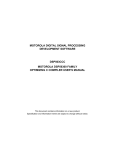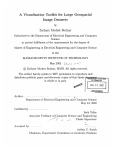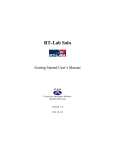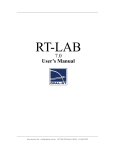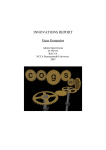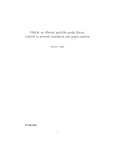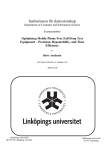Download Extension manual
Transcript
Graphana - program extension
Several parts of Graphana can be extended. All extensions are done through java classes.
This manual focusses on adding operations.
Contents
1 The framework
2 Operations
2.1 Operation types . . . . . . .
2.2 Signatures . . . . . . . . . .
2.3 Execute method . . . . . . .
2.3.1 Operation arguments
2.3.2 Operation return . .
2.4 Subclasses of Operation . .
2.4.1 Commands . . . . .
2.4.2 Graph operations . .
2.4.3 Graph algorithms . .
2.5 Operation groups . . . . . .
2
.
.
.
.
.
.
.
.
.
.
.
.
.
.
.
.
.
.
.
.
.
.
.
.
.
.
.
.
.
.
.
.
.
.
.
.
.
.
.
.
1
.
.
.
.
.
.
.
.
.
.
.
.
.
.
.
.
.
.
.
.
.
.
.
.
.
.
.
.
.
.
.
.
.
.
.
.
.
.
.
.
.
.
.
.
.
.
.
.
.
.
.
.
.
.
.
.
.
.
.
.
.
.
.
.
.
.
.
.
.
.
.
.
.
.
.
.
.
.
.
.
.
.
.
.
.
.
.
.
.
.
.
.
.
.
.
.
.
.
.
.
.
.
.
.
.
.
.
.
.
.
.
.
.
.
.
.
.
.
.
.
.
.
.
.
.
.
.
.
.
.
.
.
.
.
.
.
.
.
.
.
.
.
.
.
.
.
.
.
.
.
.
.
.
.
.
.
.
.
.
.
.
.
.
.
.
.
.
.
.
.
.
.
.
.
.
.
.
.
.
.
.
.
.
.
.
.
.
.
.
.
.
.
.
.
.
.
.
.
.
.
.
.
.
.
.
.
.
.
.
.
5
. 5
. 5
. 6
. 6
. 7
. 8
. 8
. 8
. 10
. 11
1 The framework
This section deals with using the framework in order to develop operations, especially algorithms. The basics of using Graphana as a framework are also described in
’graphana_manual.pdf’, but a bit more detailed. To try out what is described in this
section, a new java project with a main class should be created.
Firstly, the framework has to be imported. When writing a java application in eclipse,
Graphana can be imported by clicking Project → Properties → Java build path →
Libraries → Add external jars and choosing the ’graphana.jar’ file.
The easiest way to initialize the framework and to execute operations is to create a
GraphanaAccess instance. This class initializes Graphana and automatically registers all
the default operations and libraries:
GraphanaAccess graphanaAccess = new GraphanaAccess ( ) ;
This can be done within the main method. Now in order to add operations, firstly, a
class which extends from a subclass of Operation must be created. Especially to add an
algorithm, a class which extends GraphAlgorithm must be created. This should be done
in a separate java file.
The following example is a graph algorithm, which sums up the edge weights of all incident
edges of a given vertex. The implementation details of the sample are not important at
the moment. They will become clear after reading the other subsections. The focus is on
creating and using own algorithms:
public c l a s s AlgoEdgeWeightSum extends GraphAlgorithm {
// S i g n a t u r e o f t h e a l g o r i t h m t o c a l l i t d u r i n g runtime
@Override
protected S t r i n g g e t S i g n a t u r e S t r i n g ( ) {
return " getEdgeWeightSum ␣ ( v e r t e x : Vertex ) ␣ : ␣ F l o a t " ;
}
// I m p l e m e n t a t i o n o f t h e a l g o r i t h m
@Override
protected <VertexType , EdgeType> ExecutionReturn e x e c u t e (
GraphLibrary<VertexType , EdgeType> graph ,
UserInterface userInterface ,
OperationArguments a r g s )
{
// S t a r t w i t h z e r o
f l o a t weightSum = 0 ;
// E x t r a c t t h e v e r t e x g i v e n by t h e u s e r
VertexType v e r t e x = a r g s . getVertexArg ( 0 ) ;
// I t e r a t e o v e r a l l i n c i d e n t e d g e s o f t h e g i v e n v e r t e x
for ( EdgeType edge : graph . g e t I n c i d e n t E d g e s ( v e r t e x ) ) {
//Add t h e w e i g h t o f t h e c u r r e n t edge t o t h e r e s u l t
weightSum += graph . getEdgeWeight ( edge ) ;
}
// Return t h e f l o a t wrapped w i t h i n a GFloat
2
return new GFloat ( weightSum ) ;
}
}
Now back in the main class, the algorithm can be registered by calling the following
GraphanaAccess-method:
public void r e g i s t e r O p e r a t i o n ( Operation o p e r a t i o n )
In the case of the example above, the call would look like this:
graphanaAccess . r e g i s t e r O p e r a t i o n (new AlgoEdgeWeightSum ( ) ) ;
Afterwards, the algorithm can be called within a Graphana statement using the key
defined in the signature. The following main method creates a constant testcase for the
algorithm: After initialization and registration, the example creates a test graph instance
by adding constant vertices and edges. Afterwards, the graph is visualized and the result
is printed and finally the user interface main loop is started.
public s t a t i c void main ( S t r i n g [ ] a r g s )
{
// I n i t i a l i z e
GraphanaAccess graphanaAccess = new GraphanaAccess ( ) ;
// R e g i s t e r t h e a l g o r i t h m
graphanaAccess . r e g i s t e r O p e r a t i o n (new AlgoEdgeWeightSum ( ) ) ;
// Create t e s t graph i n s t a n c e
graphanaAccess . e x e c u t e ( " createGraph ( t r u e , t r u e ) ; " ) ;
// c r e a t e v e r t i c e s v0 , v1 , v2 , v3 , v4
graphanaAccess . e x e c u t e ( "addVertexRow ( 5 , 0 , ’ v ’ ) " ) ;
graphanaAccess . e x e c u t e ( "addEdge ( $v1 , $v0 , ␣ 2 ) " ) ;
graphanaAccess . e x e c u t e ( "addEdge ( $v2 , $v1 , ␣ 3 ) " ) ;
graphanaAccess . e x e c u t e ( "addEdge ( $v1 , $v4 , ␣ 4 ) " ) ;
graphanaAccess . e x e c u t e ( "addEdge ( $v2 , $v0 , ␣ 1 ) " ) ;
graphanaAccess . e x e c u t e ( "addEdge ( $v3 , $v4 , ␣ 5 ) " ) ;
// V i s u a l i z e t h e graph , a l l o w graph m o d i f i c a t i o n
graphanaAccess . g e t U s e r I n t e r f a c e ( ) . showGraph ( true ) ;
// P r i n t t h e a l g o r i t h m r e s u l t
System . out . p r i n t l n (
"Sum␣ o f ␣ w e i g h t s ␣ o f ␣ i n c i d e n t ␣ e d g e s ␣ o f ␣ v1 : ␣"
+ graphanaAccess . e x e c u t e F l o a t ( " getEdgeWeightSum ( $v1 ) " )
+ "␣ ( e x p e c t e d : ␣ 9 . 0 ) "
);
// S t a r t u s e r i n t e r f a c e main l o o p
graphanaAccess . g e t U s e r I n t e r f a c e ( ) . mainLoop ( ) ;
}
The example ignores error handling which is described in the Graphana manual. Therefore, if an error occurs, the stack trace will be printed and the program will be interrupted.
3
After printing the result, the program is still running. To further test the algorithm during
runtime, the following steps can be done for example:
• Right click on an empty area within the visualization window to create a new vertex.
• Right press onto the new vertex and release the right mouse button on ’v1’ to add
a new edge, which initially has weight 1.
• Switch to the console, type ’setEdgeWeight($v5->$v1, 6)’ and press enter. This
changes the weight of the new edge to 6.
• Type getEdgeWeightSum($v1) (or try any other vertex) and press enter. Verify the
result with the visual output.
This visual way of testing algorithms works well for small test graphs. For larger graphs,
java assertions or Graphana assertions should be preferred.
Now the implementation is finished and the algorithm is ready to be provided. When
compiling the application, the file ’AlgoEdgeWeightSum.class’ is generated. This file can
now for example be copied into a ’plugins’ folder in the graphana.jar directory. After starting the jar, the class can be imported. The following shell commands (in the graphana.jar
directory) demonstrate this:
java -jar graphana.jar
>import("plugins/AlgoEdgeWeightSum.class")
With this, any Graphana user can call the operation by only retrieving the class and not
the whole test application.
The test application can now be used to test out the concepts of the next section.
4
2 Operations
This section contains a detailed description on implementing operations.
2.1 Operation types
For a users view on operations, see ”graphana_manual.pdf”. This subsection deals with
a programmers view.
The basic class for operations is Operation. As already mentioned in the user manual,
there are three types of operations. All of them are subclasses of Operation:
• Graph operations: When derivating from GraphOperation, the main input is a
graph. This graph can then be manipulated for example.
• Graph algorithms: When derivating from GraphAlgorithm, which is a subclass of
GraphOperation, a graph is still the main input but is not supposed to be modified,
but to calculate a result, like a graphparameter.
• Commands: Classes which derivate from Command usually do not operate on a
graph, but do some general settings, like for example configure algorithms before
executing them. Some of them calculate something which does not have to do
anything with graphs, like for example the square root of a given number.
To add a new Graphana operation, a class, which extends one of the three Operationsubclasses must be implemented and then an instance must be registered in the program
(registration will be explained later).
2.2 Signatures
At runtime, every operation is identified by an unique key, can receive arguments and
can return a result. All Operation-subclasses have this in common. They must define a
signature to determine key, parameters and return type. The following method must be
implemented:
protected S t r i n g g e t S i g n a t u r e S t r i n g ( ) ;
The signature must be returned as a string in the following simplified syntax:
operationKey[|alias1|alias2...] [(
parameterName:ParameterType1;
paramName2:ParamType2;
...
paramNameN:paramTypeN
)] [: ReturnType]
Everything in square brackets is optional. Whitespaces, including linebreaks, are ignored
when evaluating the signature. The signature will be shown to the user when he types
HELP and the operation key or one of the aliases.
One example for a signature is the following one:
edgeExists|connected (vertex1:Vertex; vertex2:Vertex) : Boolean
The operation of the sample signature can be called either with ’edgeExists’ or with the
alias ’connected’. It receives two vertices and returns a boolean.
5
2.3 Execute method
Every type of operation has an execute method, which is called, when the operation is
called by the user or within a script. The execute method is not the same for every
operation type. However, all types can receive arguments and can return a result. For
example, the execute method of a command has the following signature:
protected ExecutionReturn e x e c u t e ( MainControl mainControl ,
OperationArguments a r g s )
Commands will be explained later.
2.3.1 Operation arguments
An execute method receives an argument args of type OperationArguments. It contains
the evaluated arguments of the operation call. The particular arguments can be read
using the getX Arg methods, where X is the respective argument type, for example
getFloatArg. The arguments are identified with their index whereas the first argument
has the index 0. If the type is not determined in the signature (Any) then the argument
can be accessed with getArg(Integer index) which returns the argument as a java
Object.
So for example, to get the third argument, assuming that this argument is of type Integer,
then the call within the execute method would look like this:
I n t e g e r ar g = a r g s . g e t I n t A r g ( 2 ) ;
The getX Arg call must be consistent to the signature. Otherwise a java exception is
thrown.
It is also possible to define operations which can receive an arbitrary number of arguments by writing three dots (”. . . ”) at the end of the parameter list. In this case, the
caller can pass arguments of the type of the last parameter in the list at any number. The
args.count() method gives the overall number of given arguments.
For example, an operation with the signature
printObjects (separator:String; objects:Any ...)
can be called by the user for example with:
printObjects(";",
"A string", 56, "Another string")
The arguments can be accessed like this within the execute method:
String separator = args . getStringArg ( 0 ) ;
for ( int i =1; i <a r g s . count ( ) ; i ++)
System . out . p r i n t l n ( a r g s . getArg ( i ) . t o S t r i n g ( ) + s e p a r a t o r ) ;
The output would be:
A string;56;Another string;
It is possible to define default values for the parameters of a signature by writing a =
and the value in Graphana-syntax after the type of the parameter. If a parameter has
a default value then the caller does not need to pass the respective argument and the
default value is used instead. For example such a signature could look like this:
6
addEdge (vertex1:Vertex; vertex2:Vertex; weight:Integer=1)
With the sample signature, the caller can optionally give an edge weight.
If a parameter of the list has a default value then all following parameters also need a
default value consequently. In the execute method when using the args instance, it is not
distinguished between arguments which were explicitely passed in the call and arguments
which were passed as default values. Especially, args.count also counts the default values
in.
2.3.2 Operation return
Every execute method must return a value of type ExecutionReturn. If the operation
actually shall not return a result, then ExecutionReturn.VOID must be returned. If
the operation computes a result, then an instance of a subclass of ExecutionResult
must be returned. There are several predefined subclasses, one for each Graphana type.
Examples are GInteger, GBoolean and GString. Every instance holds a value of the
respective type.
For example, if an operation returns a String then the return statement of the execute
method could look like this:
return new GString ( " This ␣ i s ␣a␣ s t r i n g . " )
If an error occurs during execution then an instance of an ExecutionError or a subclass
like ExecutionErrorMessage can be returned:
i f ( g e t F l o a t A r g (0) >1)
return new E x e c u t i o n E r r o r M e s s a g e (
"Only␣ v a l u e s ␣ s m a l l e r ␣ than ␣1␣ a l l o w e d . " )
The following image depicts an extract of the structure of the ExecutionReturn subclasses:
The figure shows an extract of the relation between the ExecutionReturn subclasses. GInteger,
GFloat etc. are just samples.
One special case is the GBoolean class: It cannot be instantiated directly, but by using
GBoolean.create(boolean), GBoolean.TRUE or GBoolean.FALSE.
7
2.4 Subclasses of Operation
This subsection deals with the different types of operations and with the differences between them.
2.4.1 Commands
The signature of the execute method of a command is the following:
protected ExecutionReturn e x e c u t e ( MainControl mainControl ,
OperationArguments a r g s )
The parameter mainControl gives access to the configuration and dates of
the program.
Especially, it gives access to the UserInterface by calling
mainControl.getUserInterface(). Using the returned interface a string can be printed
with the method UserInterface.userOutput(String message).
For example, a simple command which devides an Integer with a Float could look like
this:
private c l a s s D i v i s i o n extends Command
{
@Override
protected S t r i n g g e t S i g n a t u r e S t r i n g ( )
{
//The s i g n a t u r e as a c o n s t a n t S t r i n g
return " d i v i d e | d i v ␣ ( d i v i d e n d : I n t e g e r ; ␣ d i v i s o r : F l o a t ) ␣ : ␣ F l o a t " ;
}
@Override
protected ExecutionReturn e x e c u t e ( MainControl mainControl ,
OperationArguments a r g s )
{
int d i v i d e n d = a r g s . g e t I n t A r g ( 0 ) ;
float d i v i s o r = args . getFloatArg ( 1 ) ;
// Check , w h e t h e r t h e d i v i s o r i s z e r o
i f ( d i v i s o r == 0 )
return new E x e c u t i o n E r r o r M e s s a g e ( " D i v i s i o n ␣by␣ 0 . " ) ;
else
return new GFloat ( d i v i d e n d / d i v i s o r ) ;
}
}
After registration, which was explained in the very first section, the sample command can
either be called with divide or with div. The signature ensures, that the operation can
be called only if an integer is given as the first and a float is given as the second argument.
So for example the command can be used like this in the running program:
res = divide(78, 0.5);
2.4.2 Graph operations
Graph operations operate on graphs to modify it or to extract informations. Therefore
the execute method receives a GraphLibrary including the generic types:
8
protected <VertexType , EdgeType> ExecutionReturn e x e c u t e (
GraphLibrary<VertexType , EdgeType> graph ,
U s e r I n t e r f a c e u s e r I n t e r f a c e , OperationArguments a r g s )
The userInterface and the args parameters are already explained in the prior subsection. The given graph contains a set of basic graph operations like insertion, deletion and
iteration of vertices. If the graph operation is written for a special graph library, then
the internal graph can be accessed using graph.getInternalGraph(), which returns an
Object so a type cast to the respective graph class must be done explicitely. Alternatively,
a graph operation can use the higher level methods of the given graph to be independent
of the internal graph library.
This sample graph operation simply adds a vertex with the given identifier to the graph:
p r i v a t e c l a s s ExecAddVertex e x t e n d s GraphOperation
{
@Override
protected String getSignatureString ()
{
//The s i g n a t u r e s t r i n g o f t h e a l g o r i t h m
r e t u r n " addVertex ( i d e n t i f i e r : S t r i n g ) : v o i d " ;
}
@Override
p r o t e c t e d <VertexType , EdgeType> ExecutionReturn e x e c u t e (
GraphLibrary<VertexType , EdgeType> graph ,
UserInterface userInterface ,
OperationArguments a r g s )
{
// add a v e r t e x t o t he g i v e n graph
graph . addVertex ( a r g s . g e t S t r i n g A r g ( 0 ) ) ;
// This o p e r a t i o n does not r e t u r n a r e s u l t
r e t u r n ExecutionReturn . VOID ;
}
}
The operation works for every graph library, because it only uses the higher level method
GraphLibary.addVertex and therefore never accesses the internal graph directly.
Graph preconditions
A graph operation can set up some graph preconditions. That means, that, in addition to the fact that the operation cannot be called with the invalid argument types, a
graph operation cannot be called if the respective graph does not fullfill the graph preconditions. Therefore, there is no need to check the conditions within the execute method
and to do error handling. Furthermore, the graph preconditions are automatically listed
in the documentation of the operation. The graph preconditions of a graph operation can
be configured by calling the respective methods in the super class, which will be explained
in the following.
9
The following method determines, with which graph libraries the operation can be called:
protected f i n a l void s e t C o m p a t i b l e L i b s (
GraphLibrary <? ,? >[] c o m p a t i b l e L i b s )
If setCompatibleLibs is never called then the operation is assumed to be compatible
with every graph library, which means that it does not access the internal graph directly
but work with the higher level methods offered by GraphLibary.
In addition, an operation can allow and disallow graph configurations by calling the
following method:
protected f i n a l void setAllowedGraphConfig (
boolean d i r e c t e d A l l o w e d ,
boolean notSimpleAllowed ,
boolean emptyAllowed )
If directedAllowed is false then the given graph is always undirected.
If
notSimpleAllowed is false then the graph does not have loops. If emptyAllowed is
false then the graph has at least one vertex.
If the following method is called then the received graph is always directed:
protected f i n a l void setAlwaysConvertToDirected ( )
A graph will automatically be converted into an equivalent directed graph when the operation is called with an undirected graph.
If the following method is called then the received graph is always a deep copy of the
original graph:
protected f i n a l void setAlwaysCopy ( )
This is useful, if the graph operation for example modifies the graph temporally to compute something. The original graph will not be affected.
The configuration methods can be called within the getSignature method or within
the constructor, but never within the execute method. An example will be shown in the
next subsection.
2.4.3 Graph algorithms
Algorithms are special graph operations so everything that was explained in the previous
subsection is also true for algorithms. The execute method has the same signature as the
execute method of graph operations and the graph preconditions are working the same
way. There are only few differences. For example the algorithm counter does not measure
the time of graph operations but only of algorithms.
The following sample is the vertex cover size GraphAlgorithm. Basically, the class only
calls the vertex cover algorithm of JGraphT:
public c l a s s A l g o V e r t e x C o v e r S i z e extends GraphAlgorithm {
10
@Override
public S t r i n g g e t S i g n a t u r e S t r i n g ( )
{
//GRAPH PRECONDITIONS
//The a l g o r i t h m can o n l y be c a l l e d w i t h JGraphT
t h i s . s e t C o m p a t i b l e L i b (new JGraphTLib ( ) ) ;
//The graph must be u n d i r e c t e d and s i m p l e .
// Theres no r e s t r i c t i o n f o r w e i g h t e d / u n w e i g h t e d
t h i s . setAllowedGraphConfig ( f a l s e , true , f a l s e ) ;
//The s i g n a t u r e s t r i n g o f t h e a l g o r i t h m
return
" v e r t e x C o v e r S i z e | v e r t e x C o v e r ␣ ( useGreedy : Boolean ) ␣ : ␣ I n t e g e r " ;
}
@Override
protected <VertexType , EdgeType> ExecutionReturn e x e c u t e (
GraphLibrary<VertexType , EdgeType> graph ,
UserInterface userInterface ,
OperationArguments a r g s )
{
//The i n t e r n a l graph can o n l y be o f t h e JGraphT t y p e
// UndirectedGraph b e c a u s e o f t h e graph p r e c o n d i t i o n s
UndirectedGraph<VertexType , EdgeType> i n t e r n a l G r a p h =
( UndirectedGraph<VertexType , EdgeType>)graph . g e t I n t e r n a l G r a p h ( ) ;
Set<VertexType> c o v e r ;
//The argument d e t e r m i n e s , which h e u r i s t i c s h a l l be used
i f ( a r g s . getBoolArg ( 0 ) )
c o v e r = VertexCovers . findGreedyCover ( i n t e r n a l G r a p h ) ;
else
c o v e r = VertexCovers . find2ApproximationCover ( i n t e r n a l G r a p h ) ;
// Return t h e r e s u l t as an I n t e g e r
return new G I n t e g e r ( c o v e r . s i z e ( ) ) ;
}
}
2.5 Operation groups
Operations can be gathered in groups by derivating from OperationGroup. The following
method must be implemented:
public Operation [ ] g e t O p e r a t i o n s ( ) ;
The method must return an array of instances of the operations which shall be registered
when registering the group. The registration of a group works the same way as with single
operations.
For example the commands startCounter and getCounter are subclasses gathered in
11
one group so they can easily share a variable:
public c l a s s CmdsCounter extends OperationGroup {
long t i m e r ;
private c l a s s ExecStartCounter extends Command
{
@Override
protected ExecutionReturn e x e c u t e ( MainControl mainControl ,
OperationArguments a r g s )
{
t i m e r = System . c u r r e n t T i m e M i l l i s ( ) ;
return ExecutionReturn . VOID ;
}
@Override
protected S t r i n g g e t S i g n a t u r e S t r i n g ( )
{
return " s t a r t C o u n t e r | r e s t a r t C o u n t e r | s e t C o u n t e r ␣ : ␣ v o i d " ;
}
}
private c l a s s ExecGetCounter extends Command
{
@Override
protected ExecutionReturn e x e c u t e ( MainControl mainControl ,
OperationArguments a r g s )
{
i f ( timer <=0)
return new E x e c u t i o n E r r o r M e s s a g e
( " Counter ␣ not ␣ s e t ␣ y e t . ␣ C a l l ␣ ’ s t a r t c o u n t e r ’ ␣ f i r s t . " ) ;
else
return new G I n t e g e r
( ( int ) ( System . c u r r e n t T i m e M i l l i s ()− t i m e r ) ) ;
}
@Override
protected S t r i n g g e t S i g n a t u r e S t r i n g ( )
{
return " getCounter ␣ : ␣ I n t e g e r " ;
}
}
@Override
public Command [ ] g e t O p e r a t i o n s ( )
{
return new Command [ ] {
new ExecStartCounter ( ) ,
12
new ExecGetCounter ( )
};
}
Both commands are inner classes and share the variable timer. To register the two commands, only the group CmndsCounter has to be registered. When using GraphanaAccess,
the registration looks like this:
graphanaAccess . r e g i s t e r O p e r a t i o n s (new CmdsCounter ( ) ) ;
13


















